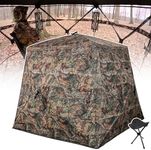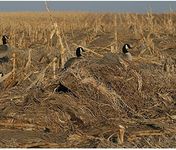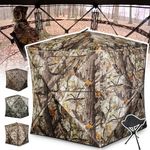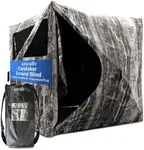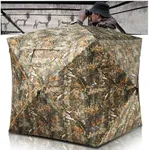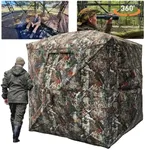Buying Guide for the Best Duck Hunting Blinds
Choosing the right duck hunting blind is crucial for a successful and enjoyable hunting experience. A good blind will help you stay hidden from ducks, provide comfort during long hours of waiting, and offer protection from the elements. When selecting a duck hunting blind, consider the environment you'll be hunting in, the number of people it needs to accommodate, and the level of portability you require. Here are some key specifications to consider when choosing a duck hunting blind.CamouflageCamouflage is the pattern and color of the blind that helps it blend into the surrounding environment. This is important because ducks have keen eyesight and can easily spot unnatural shapes and colors. Camouflage patterns vary based on the type of terrain, such as marsh, woodland, or open field. Choose a pattern that matches the environment where you'll be hunting most often. If you hunt in multiple environments, consider a blind with interchangeable camo covers.
Size and CapacityThe size and capacity of a duck hunting blind determine how many hunters and gear it can accommodate. This is important for comfort and functionality. Blinds come in various sizes, from single-person layouts to large, multi-person setups. If you usually hunt alone or with one partner, a smaller blind will suffice. For group hunts, opt for a larger blind that can comfortably fit everyone and their equipment. Consider the interior height as well, especially if you need to stand up to shoot.
PortabilityPortability refers to how easy it is to transport and set up the blind. This is important if you need to move frequently or travel long distances to your hunting spot. Blinds range from lightweight, foldable designs to heavier, more permanent structures. If you need to carry your blind over long distances or through difficult terrain, choose a lightweight, compact model. For more permanent setups, a heavier, more durable blind may be suitable.
Material and DurabilityThe material and durability of the blind affect its longevity and ability to withstand harsh weather conditions. This is important for ensuring your blind lasts through multiple hunting seasons. Common materials include polyester, nylon, and canvas, each offering different levels of water resistance and durability. If you hunt in wet or harsh conditions, look for a blind made from waterproof and windproof materials. For milder climates, a lighter material may be sufficient.
Concealment FeaturesConcealment features include elements like brush loops, windows, and shooting ports that help you stay hidden while providing functionality. This is important for maintaining stealth and having a clear shot at ducks. Brush loops allow you to add natural vegetation to the blind for better blending. Windows and shooting ports should be strategically placed to offer good visibility and shooting angles without exposing you. Choose a blind with adjustable features to customize your concealment based on the hunting situation.
ComfortComfort features include seating, space, and ventilation within the blind. This is important for staying comfortable during long hours of hunting. Look for blinds with built-in seats or enough space to bring your own. Adequate ventilation is crucial to prevent condensation and maintain a comfortable temperature inside the blind. If you plan to spend extended periods in the blind, prioritize models with padded seats and ample legroom.


